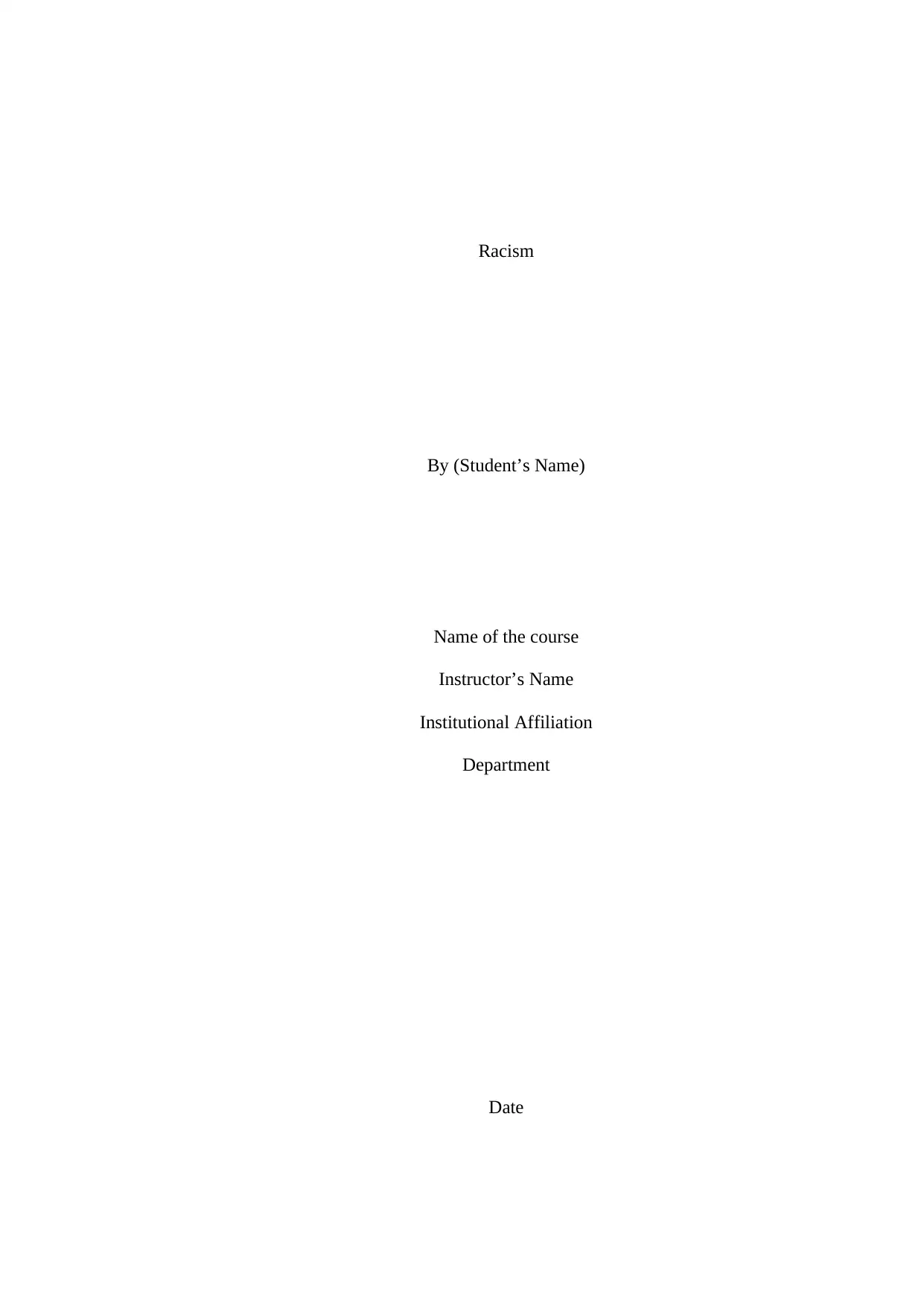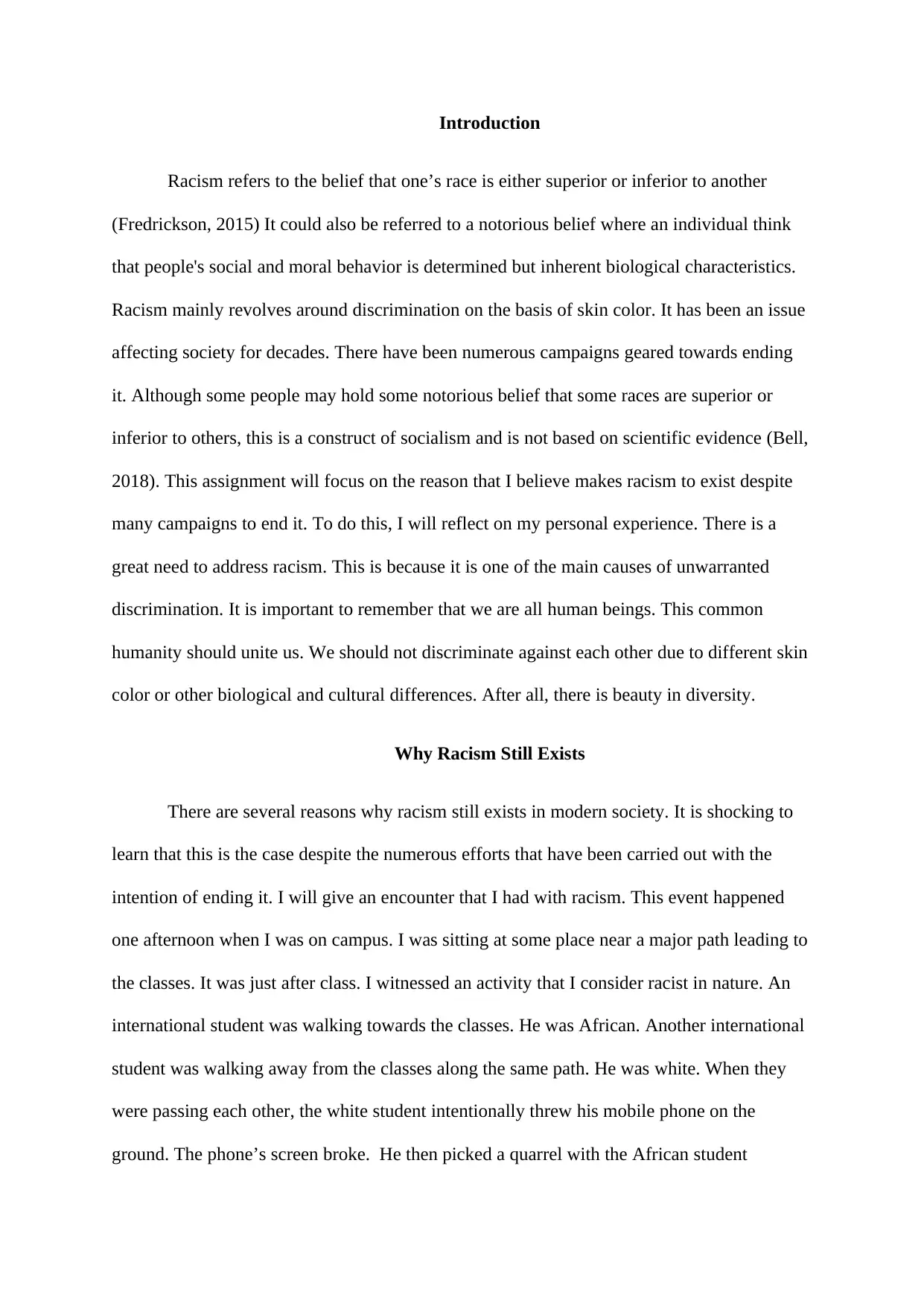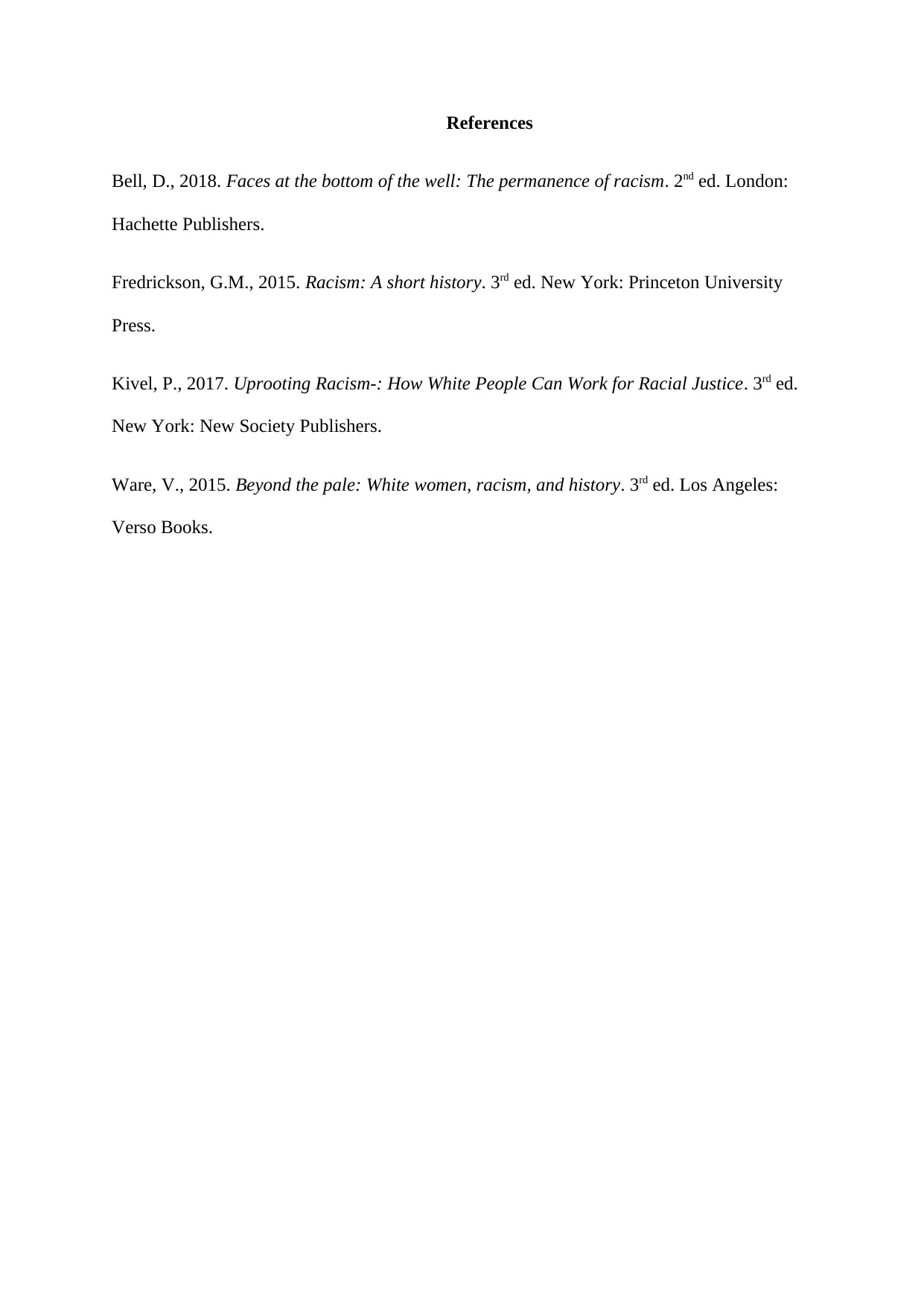Case Study: Racism in Society - Personal Experience and Reflection
VerifiedAdded on 2023/01/12
|5
|976
|22
Case Study
AI Summary
This case study examines the persistence of racism in modern society through a reflective analysis of a personal experience. The author defines racism as the belief in the superiority or inferiority of a race and discusses its impact on discrimination. The assignment details an encounter where a white student seemingly instigated a conflict with an African student, highlighting prejudiced attitudes. The author argues that racism continues due to ingrained attitudes and the potential for its transmission across generations. The paper emphasizes the importance of changing attitudes and renewing minds to end racism, while acknowledging that the author believes that racism is becoming less common. The assignment concludes by referencing historical and contemporary examples of racism and discrimination, while hoping for a future where racism is completely eradicated.

Racism
By (Student’s Name)
Name of the course
Instructor’s Name
Institutional Affiliation
Department
Date
By (Student’s Name)
Name of the course
Instructor’s Name
Institutional Affiliation
Department
Date
Paraphrase This Document
Need a fresh take? Get an instant paraphrase of this document with our AI Paraphraser

Introduction
Racism refers to the belief that one’s race is either superior or inferior to another
(Fredrickson, 2015) It could also be referred to a notorious belief where an individual think
that people's social and moral behavior is determined but inherent biological characteristics.
Racism mainly revolves around discrimination on the basis of skin color. It has been an issue
affecting society for decades. There have been numerous campaigns geared towards ending
it. Although some people may hold some notorious belief that some races are superior or
inferior to others, this is a construct of socialism and is not based on scientific evidence (Bell,
2018). This assignment will focus on the reason that I believe makes racism to exist despite
many campaigns to end it. To do this, I will reflect on my personal experience. There is a
great need to address racism. This is because it is one of the main causes of unwarranted
discrimination. It is important to remember that we are all human beings. This common
humanity should unite us. We should not discriminate against each other due to different skin
color or other biological and cultural differences. After all, there is beauty in diversity.
Why Racism Still Exists
There are several reasons why racism still exists in modern society. It is shocking to
learn that this is the case despite the numerous efforts that have been carried out with the
intention of ending it. I will give an encounter that I had with racism. This event happened
one afternoon when I was on campus. I was sitting at some place near a major path leading to
the classes. It was just after class. I witnessed an activity that I consider racist in nature. An
international student was walking towards the classes. He was African. Another international
student was walking away from the classes along the same path. He was white. When they
were passing each other, the white student intentionally threw his mobile phone on the
ground. The phone’s screen broke. He then picked a quarrel with the African student
Racism refers to the belief that one’s race is either superior or inferior to another
(Fredrickson, 2015) It could also be referred to a notorious belief where an individual think
that people's social and moral behavior is determined but inherent biological characteristics.
Racism mainly revolves around discrimination on the basis of skin color. It has been an issue
affecting society for decades. There have been numerous campaigns geared towards ending
it. Although some people may hold some notorious belief that some races are superior or
inferior to others, this is a construct of socialism and is not based on scientific evidence (Bell,
2018). This assignment will focus on the reason that I believe makes racism to exist despite
many campaigns to end it. To do this, I will reflect on my personal experience. There is a
great need to address racism. This is because it is one of the main causes of unwarranted
discrimination. It is important to remember that we are all human beings. This common
humanity should unite us. We should not discriminate against each other due to different skin
color or other biological and cultural differences. After all, there is beauty in diversity.
Why Racism Still Exists
There are several reasons why racism still exists in modern society. It is shocking to
learn that this is the case despite the numerous efforts that have been carried out with the
intention of ending it. I will give an encounter that I had with racism. This event happened
one afternoon when I was on campus. I was sitting at some place near a major path leading to
the classes. It was just after class. I witnessed an activity that I consider racist in nature. An
international student was walking towards the classes. He was African. Another international
student was walking away from the classes along the same path. He was white. When they
were passing each other, the white student intentionally threw his mobile phone on the
ground. The phone’s screen broke. He then picked a quarrel with the African student

claiming that he was the one who was responsible for the breakage. The commotion lasted for
a few minutes. This was clearly a racist act. The white student must have had a high disregard
for the African student for him to perpetrate such an action. One of the reasons why racism
has never ended is because most people have not yet changed their attitudes towards it.
Although racism was common many years ago, the notion of it has never been
eradicated in the minds of most people (Ware, 2015). This is why they tend to treat their race
either as superior or weaker to another. Extensive evidence reveals that a child who is raised
by parents who have some aspects of racism has higher chances of emulating those aspects.
This would mean that these aspects will be handed down to generations. It is very important
to ensure that we end the traces of racism that may be still remaining in our minds. This is the
only true way to ensure that racism is brought to an end. Other methods may never work
unless we have a complete change of attitude and renewal of our minds. It beats logic that a
university student would be a racist. True education should change our world view. Our
reasoning should be based on simple logic.
Conclusion
Although there are still a few cases of racism, I believe that racism is becoming rare.
In the early days, racism was so common. It was so common that some people would be sold
as slaves on the basis of their skin color. The aspect of colonization also shows that there are
some people who considered their race superior. In the United States of America, racial
discrimination was so great that even the police would deal with African Americans in a
brutal manner. Such cases are not common today. It would, therefore, be true to conclude that
racism is reducing. Such cases as the one I encountered could be considered an outlier. The
reduction in the cases of racism could be attributed to the efforts of many men and women.
An example would be Martin Luther King Junior. Election of a black president in the United
a few minutes. This was clearly a racist act. The white student must have had a high disregard
for the African student for him to perpetrate such an action. One of the reasons why racism
has never ended is because most people have not yet changed their attitudes towards it.
Although racism was common many years ago, the notion of it has never been
eradicated in the minds of most people (Ware, 2015). This is why they tend to treat their race
either as superior or weaker to another. Extensive evidence reveals that a child who is raised
by parents who have some aspects of racism has higher chances of emulating those aspects.
This would mean that these aspects will be handed down to generations. It is very important
to ensure that we end the traces of racism that may be still remaining in our minds. This is the
only true way to ensure that racism is brought to an end. Other methods may never work
unless we have a complete change of attitude and renewal of our minds. It beats logic that a
university student would be a racist. True education should change our world view. Our
reasoning should be based on simple logic.
Conclusion
Although there are still a few cases of racism, I believe that racism is becoming rare.
In the early days, racism was so common. It was so common that some people would be sold
as slaves on the basis of their skin color. The aspect of colonization also shows that there are
some people who considered their race superior. In the United States of America, racial
discrimination was so great that even the police would deal with African Americans in a
brutal manner. Such cases are not common today. It would, therefore, be true to conclude that
racism is reducing. Such cases as the one I encountered could be considered an outlier. The
reduction in the cases of racism could be attributed to the efforts of many men and women.
An example would be Martin Luther King Junior. Election of a black president in the United
⊘ This is a preview!⊘
Do you want full access?
Subscribe today to unlock all pages.

Trusted by 1+ million students worldwide

States is an illustration that racism has greatly subsided (Kivel, 2017). Hopefully, racism will
end completely in the future. There has been various laws and regulations put in place by
governments all over the world to ensure that racism is eradicated. However, racism will only
end with a change of attitude and renewal of the mind.
end completely in the future. There has been various laws and regulations put in place by
governments all over the world to ensure that racism is eradicated. However, racism will only
end with a change of attitude and renewal of the mind.
Paraphrase This Document
Need a fresh take? Get an instant paraphrase of this document with our AI Paraphraser

References
Bell, D., 2018. Faces at the bottom of the well: The permanence of racism. 2nd ed. London:
Hachette Publishers.
Fredrickson, G.M., 2015. Racism: A short history. 3rd ed. New York: Princeton University
Press.
Kivel, P., 2017. Uprooting Racism-: How White People Can Work for Racial Justice. 3rd ed.
New York: New Society Publishers.
Ware, V., 2015. Beyond the pale: White women, racism, and history. 3rd ed. Los Angeles:
Verso Books.
Bell, D., 2018. Faces at the bottom of the well: The permanence of racism. 2nd ed. London:
Hachette Publishers.
Fredrickson, G.M., 2015. Racism: A short history. 3rd ed. New York: Princeton University
Press.
Kivel, P., 2017. Uprooting Racism-: How White People Can Work for Racial Justice. 3rd ed.
New York: New Society Publishers.
Ware, V., 2015. Beyond the pale: White women, racism, and history. 3rd ed. Los Angeles:
Verso Books.
1 out of 5
Related Documents
Your All-in-One AI-Powered Toolkit for Academic Success.
+13062052269
info@desklib.com
Available 24*7 on WhatsApp / Email
![[object Object]](/_next/static/media/star-bottom.7253800d.svg)
Unlock your academic potential
Copyright © 2020–2025 A2Z Services. All Rights Reserved. Developed and managed by ZUCOL.





